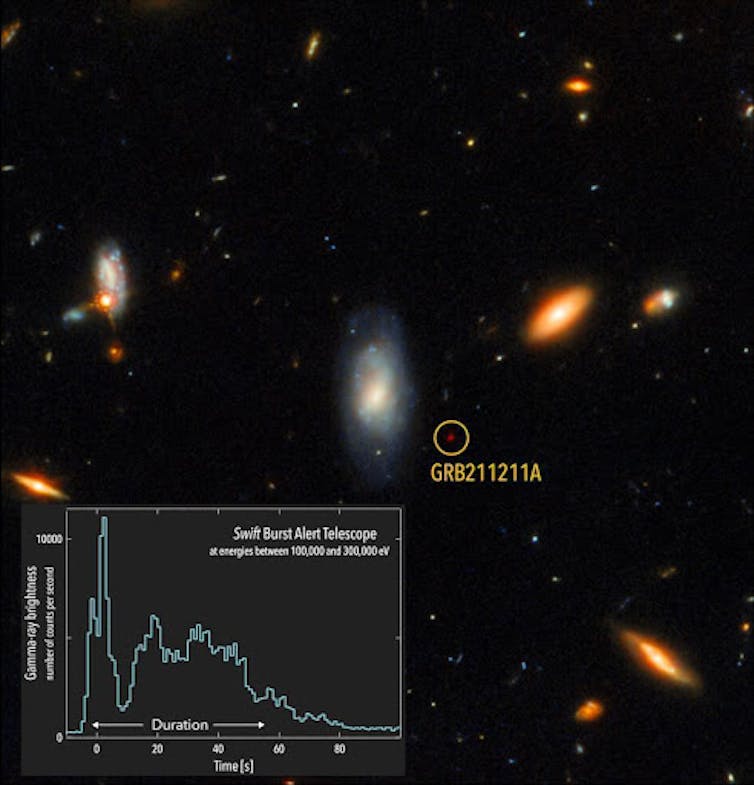An unusual, long-lasting gamma-ray burst challenges theories about how they work

A brilliant flash of gamma rays from the constellation Boötes that lasted almost one minute originated from a kilonova, as we explained in a brand-new paper This finding challenges what astronomers learn about a few of the most effective occasions in deep space.
The uncommon cosmic surge was spotted by the Neil Gehrels Swift observatory on Dec. 11, 2021, as the satellite orbited Earth. When astronomers pointed other telescopes at the part of the sky where this big blast of gamma rays-- called GRB211211 A-- originated from, they saw a radiance of noticeable and infrared light referred to as a kilonova The specific wavelengths of light originating from this surge enabled our group to determine the source of the uncommon gamma-ray burst as 2 neutron stars clashing and combining together.
Gamma rays are the most energetic kind of electro-magnetic radiation. In simply a couple of seconds, a gamma-ray burst blasts out the very same quantity of energy that the Sun will radiate throughout its whole life Gamma-ray bursts are the most effective occasions in deep space, and astronomers believe just 2 cosmic circumstances can produce gamma-ray bursts.
The most typical sources are the deaths of stars 30 to 50 times more enormous than the Sun. The devastating damage of one these big stars is called a supernova When they take off, the stars produce great voids that take in the remaining particles. These great voids release a jet of matter and electro-magnetic radiation that moves at near to the speed of light. In minutes after the great void begins producing this high-energy stream of matter and radiation, the jet produces a burst of gamma rays that can last for minutes.
The uncommon gamma-ray burst stemmed from the little red dot within the circle in this image. The chart demonstrates how brilliant and lasting the burst was. International Gemini Observatory/NOIRLab/NSF/ AURA/M. Zamani/NASA/ESA/ Eleonora Troja, CC BY-ND
Kilonovae are the 2nd kind of occasions connected with gamma-ray bursts. Kilonovae take place when a neutron star combines with another neutron star or is taken in by a great void. Neutron stars are rather little stars-- about 1.4 to 2 times the mass of the Sun, though just lots of miles throughout.
When 2 of these small, thick stars combine to produce a great void, they leave really little product behind. Compared to the lasting banquet a great void gets after a supernova, kilonovae leave a great void with bit more than a treat that leads to a gamma-ray burst that lasts just a 2nd or 2 at many
For over 20 years, astronomers believed that kilonovae accompanied brief gamma-ray bursts and supernovae accompanied long ones. When our group began looking at the wealth of information and images gathered on the minute-long burst in December 2021, we anticipated to see a supernova. Much to our surprise, we discovered a kilonova.
Why it matters
Kilonovae are cosmic factories that develop heavy metals, consisting of gold, platinum, iodine and uranium. Since they improve the chemical structure of deep space, kilonovae are crucial to supplying the standard components for the development of worlds and life.
GRB211211 A's long period of time opposes existing theories of how gamma-ray bursts connect to supernovae and kilonovae. This finding reveals that there is still a lot astronomers like us do not comprehend about these effective and essential procedures and recommends that there might be other methods deep space can produce heavy metals.
Kilonovae are accountable for producing heavy metals-- like gold, uranium and iodine-- that are necessary for lots of procedures in deep space.
What still isn't understood
The preliminary images and information collected on this intriguing occasion appear like a kilonova produced from the crash of 2 neutron stars. The lasting burst of gamma rays tosses doubt on what precisely took place. It is possible that a person of the gamers was an uncommon neutron star with an extremely effective electromagnetic field-- called a magnetar. The burst might likewise have actually been the outcome of a neutron star being torn apart by its buddy great void Or astronomers might have simply experienced a brand-new, formerly unidentified kind of excellent crash
What's next
The couple of unique outstanding encounters that produce gamma-ray bursts can look really comparable to one another throughout the electro-magnetic spectrum. The distinct gravitational wave signatures they produce might be the secret to resolving the enigma. The gravitational wave detectors LIGO, Virgo and KAGRA did not see GRB211211 A, as they were all offline for enhancements. If they can capture a long-duration gamma-ray burst after they start running once again in 2023, the mix of gravitational wave and electro-magnetic information might fix the secret of this freshly found occasion.
Eleonora Troja, Associate Professor of Astrophysics, University of Rome Tor Vergata and Simone Dichiara, Assistant Research Professor of Astrophysics, Penn State
This short article is republished from The Conversation under a Creative Commons license. Check out the initial short article
Read More https://futurenewsforyou.com/news/an-unusual-long-lasting-gamma-ray-burst-challenges-theories-about-how-they-work/?feed_id=408&_unique_id=63b3e1c795013

Comentarii
Trimiteți un comentariu